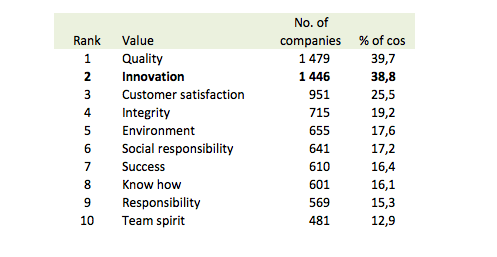Innovation is a word that is used very frequently in business meetings and written with great conviction in annual reports. Innovation is a lofty ambition that can inspire. And, it is considered by many as the single biggest driver of value. As Thierry Wellhoff, wrote in his book, “Values*,” innovation is a perennial favorite value (different from value-added) in enterprises. In the 2009 survey that was published by the Wellcom Agency (in conjunction with the International ECCO network), innovation was the #2 value, just behind quality for all international companies. Both Quality and Innovation are head and shoulders above the rest. In this survey, which looks at around 4,000 companies in 11 countries, for India, France, Holland and the UK, innovation is the #1 most cited value. Below are the top 10 values per the 2009 Wellcom survey.

Applying the innovation mindset

The innovation mindset is associated with creativity, cutting-edge technology, R&D. For the more advanced mindset, innovation is also a disruptive force. The importance and interpretation of innovation varies according to sector, but globally, innovation tends to be focused on new product (service) development. In other words, the output is customer-facing and tangible.
Does a digital mindset = an innovation mindset
When I talk about innovation being embedded in the company’s DNA, I refer to innovation belonging to all departments of the company. Innovation can very well happen in sales, factory lines, HR… Most emphatically, there are clearly ways that all employees of the company can contribute to idea generation. Yet, in each domain, there can be entirely new and radical ways of doing the business at hand. For HR, there has been a tremendous disruption in the methods of recruitment, giving the HR departments a whole new range of opportunities to change from “business as usual” to dynamic and innovative in their recruitment process. For HR, again, there are enormous opportunities in the way learning and coaching can be done. With an innovation-everywhere-mindset, each department within the organization needs to be considering how to rethink their “job”. Digital comes into play because it brings a set of options, tools, devices and technologies that, almost by definition, are new and disruptive. The real disruption, however, is not in the tool, but in the impact on internal processes, resources and management. It may be hard to conceive of innovation without some form of digital technology participating, but innovation is certainly not limited to digital. Embedding and activating a digital strategy, on the other hand, requires a shift in mindset and, I would argue that, the spirit and nature of the change is similar to that required to drive innovation deeper into the company’s fiber. In both cases, there is a necessary shift in corporate culture and mindset.
Innovation Mindset shift

There is no easy path for big business to embed innovation throughout the organization. And, there is certainly no single route to take. Carrying heritage systems and processes, enterprises are encumbered with the weight of their past successes. In Netexplo’s 2014 collation of over 1,000 new tech initiatives from around the world, just 4% came from traditional big business. To be innovative in a deep-rooted sense in big business takes a major cultural shift. Excluding the likes of the giants who have completely disrupted entire industries (Amazon, Google, Apple, Facebook…) and are causing the heartache in many cases, big businesses need to find ways to become more agile and less risk-averse. I believe that making the company more de facto customer-centric (whether B2B or B2C) is an effective way to inject more innovation into the organization. One of my core convictions is that the workforce’s dedication and belief in the company’s values and purpose can greatly contribute to infusing more innovation into a company. Moving from values on the wall or printed in an annual report into credible, lived experiences within the company is not an easy thing to achieve. Too often there is a wide gap between what is said and what is done. This sparks distrust, and can encourage a form of lethargy. {Tweet this!} Turning this around can indeed be a painful process.
Starting at the top
Whether it is imbuing the innovation mindset throughout the organization or seeding digital into the company, there is no doubt that the CEO’s dedication and inspiration are needed in both cases. For a CEO to energize the entire organization (starting with his/her Board and Executive Committee), there must be an obsession with making sure that what is said is done. That the communication messages to shareholders, prospective employees and customers is aligned. That the company installs a culture of test and learn. Knowing that the innovation mindset and digital transformation both mean accepting mistakes and failures. That, ultimately, it is a journey and not an end-game in itself. The end game, ideally, speaks to a higher purpose (than merely making the shareholders happy at the end of the month).
Your thoughts and reactions?











Trackbacks/Pingbacks